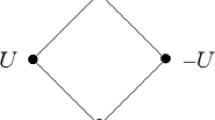Abstract
The goal of this paper is a comprehensive analysis of basic reasoning patterns that are characteristic of vague predicates. The analysis leads to rigorous reconstructions of the phenomena within formal systems. Two basic features are dealt with. One is tolerance: the insensitivity of predicates to small changes in the objects of predication (a one-increment of a walking distance is a walking distance). The other is the existence of borderline cases. The paper shows why these should be treated as different, though related phenomena. Tolerance is formally reconstructed within a proposed framework of contextual logic, leading to a solution of the Sorites paradox. Borderline-vagueness is reconstructed using certain modality operators; the set-up provides an analysis of higher order vagueness and a derivation of scales of degrees for the property in question.
Similar content being viewed by others
References
In the following Vagueness Reader refers to the anthology: Vagueness: A Reader, ed. R. Keefe & P. Smith, MIT Press, 1996. Places in articles reprinted in it are referred by page numbers in the book.
Cornelius H. (1897) Psychology als Erfahrungswissenshaft. Teubner, Leipzig, p xv + 445
Dummett, M. (1975). Wang’s paradox. Synthese, 30, 301–324. (Reprinted in Vagueness Reader).
Evans, G. (1978). Can there be vague objects? Analysis, 38, 208. (Reprinted in Vagueness Reader).
Fine, K. (1975). Vagueness, truth and logic. Synthese, 30, 265–300. (Reprinted in Vagueness Reader).
Gaifman H. (1992) Pointers to truth. The Journal of Philosophy 89: 223–262
Gaifman H. (2000) Pointers to propositions. In: Chapuis A., Gupta A. (eds) Circularity, definition, and truth. Indian Council of Philosophical Research, New Delhi, pp 79–122
Gaifman, H. (September, 2001). Contextual logic and its applications to vagueness. The Bulletin of Symbolic Logic, 7(3), 241 (Abstracts of Invited Talks of the Annual 2001 Meeting of the ASL).
Gaifman H. (2008) Contextual logic with modalities for time and space. Review of Symbolic Logic 1(4): 433–458
Hart H.L.A. (1961) The concept of law. Oxford University Press, London
Kamp H. (1981) The paradox of the heap. In: Mönnich U. (eds) Aspects of philosophical logic. Reidel, Dorderecht
Kaplan D. (1989) Demonstratives. In: Almog J., Perry J., Wettstein H. (eds) Themes from Kaplan. Oxford University Press, New York
Klein E. (1980) The semantics of positive and comparative adjectives. Linguistics and Philosophy 4: 1–45
Kofka, K. (1922). Perception: An introduction to the Gestalt-Theorie. Psychological Bulletin, 19, 531–585 (Reprinted in Classics in Psychology, ed. Thorne Shiple, 1961, Philosophical Library).
McGee, V., & McLaughlin, B. (1994). Distinctions without a difference. The Southern Journal of Philosophy, 33(Supplement), 203–251.
Putnam H. (1983) Vagueness and alternative logic. Erkenntnis 19: 297–314
Raffman D. (1994) Vagueness without paradox. The Philosophical Review 103: 41–74
Russell, B. (1923). Vagueness. Australasian Journal of Philosophy and Psychology, 1, 84–92. (Reprinted in Vagueness Reader).
Sainsbury, M. (1990). Concepts without boundaries, an Inaugural Lecture, King’s College, London. (Reprinted in part in the Vagueness Reader).
Sorensen R. (1994) A thousand clones. Mind 103: 47–54
Stumpf C. (1883) Tonepsychology I. Hirzel, Leipzig, p xiv + 427
Unger P. (1979a) I do not exist. In: Macdonald G.E. (eds) Perception and identity. MacMillan, London, pp 235–251
Unger P. (1979b) There are no ordinary things. Synthese 41: 117–154
Williamson, T. (1992). Vagueness and ignorance. In Proceedings of the Aristotelian Society, 66(Suppl), 145–162 (Reprinted in Vagueness Reader).
Williamson T. (1994) Vagueness. Routledge, London
Williamson T. (1999) On the Structure of Higher-Ord Vagueness. Mind 103: 127–143
Wright, C. (1975). On the coherence of vague predicates. Synthese, 30, 325–365. A shorter version appeared as “Language-mastery and the sorites paradox”. In G. Evans & J. Mcdowell (Eds.), Truth and meaning. Oxford: Oxford University Press, 1976. (Reprinted in Vagueness Reader).
Wright, C. (1994). Epistemic conception of vagueness. The Southern Journal of Philosophy, 33(Supplement), 133–159.
Zeeman, E. C. (1961). The topology of the brain and visual perception. In Topology of 3-manifolds and related topics, Proceedings of The University of Georgia Institute, Prentice Hall, pp. 240–256.
Author information
Authors and Affiliations
Corresponding author
Additional information
An erratum to this article can be found at http://dx.doi.org/10.1007/s11229-010-9746-y
Rights and permissions
About this article
Cite this article
Gaifman, H. Vagueness, tolerance and contextual logic. Synthese 174, 5–46 (2010). https://doi.org/10.1007/s11229-009-9683-9
Received:
Accepted:
Published:
Issue Date:
DOI: https://doi.org/10.1007/s11229-009-9683-9




